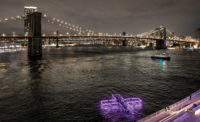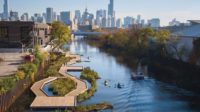
The facility, named The Floating Pool Lady in honor of its biggest champion, Ann L. Buttenwieser, is the result of a vision the urban planner and historian has worked for almost three decades to realize. While researching her dissertation on the history of the Manhattan waterfront, Buttenwieser came across the floating bathhouses that dotted the borough’s rivers in the 19th century. Inspired, she set up the Neptune Foundation with the mission of creating a prototype for a portable pool to provide, free of charge, much-needed recreational facilities for underserved communities.
Buttenwieser called on Manhattan architect Jonathan Kirschenfeld, who had related experience, having designed a 600-seat outdoor floating theater (as yet unrealized). Buttenwieser was a hands-off client, says Kirschenfeld. Beyond the standard programmatic specifications for a swimming pool, her only demand—in light of her strong belief in the coexistence of commercial and recreational interests on the urban shoreline—was that the barge relate to the existing industrial surroundings.
Originally, the plan was to create the facility from scratch. Instead, responding to rising steel prices, the foundation purchased an old, 260-foot, single-hull cargo barge in Louisiana, where marine architect C.R. Cushing & Co. completed the mechanical/electrical/plumbing and heavy steel work. Steel work included erecting the pavilion structures and cutting the opening for the pool, which involved dropping a section of the original deck down to form the pool’s floor. The barge was then towed by tug up to Brooklyn, where final retrofitting was completed before it was towed again to its new home a few piers away on the site of a forthcoming waterfront park. “Building in two places with two different contractors and shipyard technology was definitely an interesting learning experience,” says Kirschenfeld modestly.
One accesses the barge, a rugged, sea-worn vessel, by way of two gleaming aluminum gangways and arrives at a court, formed by a series of pavilions, with a children’s spray fountain at its center. The pavilions sit under a single canopy of gently pitched galvanized corrugated steel decking and house changing rooms, bathrooms, a snack bar, manager’s office, and reception. The modules, with their truncated pyramidal roofs with openings at the top, are made of steel plate painted inside with bright hues and clad with gray cement board spaced so gaps reveal the angle stiffeners behind. A balcony provides views onto the pool below, which is accessed by two long ramps that lead out from both the men’s and women’s changing rooms and cantilever, along with the rest of the pool deck, 4 feet out over the sides of the barge. (The cantilevers are the result of adapting the original design to the narrower, repurposed vessel.)
The 4-foot-deep steel pool itself is sunk into the barge’s 16-foot-deep hold, once used for ballast, and surrounded by precast-concrete pavers that sit 5 inches over the original deck. Two winglike shading pavilions flank a set of stadium steps that grace the bow, providing space for bathers to take in the pool scene or gaze out toward the downtown Manhattan skyline, the Brooklyn Bridge, and the Statue of Liberty out in the harbor.
As Buttenwieser had envisioned, the Floating Pool Lady fit right into its gritty environs, mimicking the linear forms of the neighboring warehouses. But following Labor Day, plans dictated that the barge pack up and head to New Jersey for the winter. It will return, however, perhaps to a port of call in another of the city’s boroughs, as soon as the next swimming season beckons.







Post a comment to this article
Report Abusive Comment